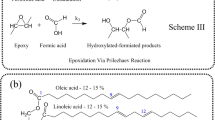Abstract
Glycidyl fatty acid esters (GEs) are by-products of edible oil refinement that have attracted attention globally due to concerns over their possible harmful effects on human health when consumed. It is thus important to improve our understanding of GE formation if we are to suppress GE production during edible oil refinement. In this paper, a first-principles density functional theory study of the formation mechanism of GEs was performed. Triglycerides undergo a self-condensation reaction between two adjacent ester groups to yield GEs and an anhydride as a by-product. This process is energetically unfavorable, having a relatively high activation energy of around 80 kcal/mol, which indicates that GE formation is intrinsically a high-temperature process. Both the thermodynamic and the kinetic energies of the reaction are insensitive to the size of the fatty chain substituents present. If water participates in the self-condensation, the activation barrier is notably decreased by 23.9 kcal/mol, indicating that GE production in the presence of high-temperature water vapor should be more kinetically favorable. Our results suggest that reducing the reaction temperature and avoiding the use of water should suppress GE production during edible oil refinement.






Similar content being viewed by others
References
Weißhaar R (2008) 3-MCPD-esters in edible fats and oils—a new and worldwide problem. Eur J Lipid Sci Technol 110:671–672
Bakhiya N, Abraham K, Gürtler R, Appel KE, Lampen A (2011) Toxicological assessment of 3-chloropropane-1,2-diol and glycidol fatty acid esters in food. Mol Nutr Food Res 55:509–521
Becalski A, Feng S, Lau BP-Y, Zhao T (2015) A pilot survey of 2- and 3-monochloropropanediol and glycidol fatty acid esters in foods on the Canadian market 2011–2013. J Food Compos Anal 37:58–66
Becalski A, Zhao T, Feng S, Lau BP-Y (2015) A pilot survey of 2- and 3-monochloropropanediol and glycidol fatty acid esters in baby formula on the Canadian market 2012–2013. J Food Compos Anal 44:111–114
Seefelder W, Varga N, Studer A, Williamson G, Scanlan FP, Stadler RH (2008) Esters of 3-chloro-1,2-propanediol (3-MCPD) in vegetable oils: significance in the formation of 3-MCPD. Food Addit Contam Part A 25:391–400
Weißhaar R, Perz R (2010) Fatty acid esters of glycidol in refined fats and oils. Eur J Lipid Sci Technol 112:158–165
Crews C, Chiodini A, Granvogl M, Hamlet C, Hrnčiřík K, Kuhlmann J, Lampen A, Scholz G, Weisshaar R, Wenzl T, Jasti PR, Seefelder W (2013) Analytical approaches for MCPD esters and glycidyl esters in food and biological samples: a review and future perspectives. Food Addit Contam Part A 30:11–45
Sawada S, Oberemm A, Buhrke T, Meckert C, Rozycki C, Braeuning A, Lampen A (2015) Proteomic analysis of 3-MCPD and 3-MCPD dipalmitate toxicity in rat testis. Food Chem Toxicol 83:84–92
Stadler RH (2015) Monochloropropane-1,2-diol esters (MCPDEs) and glycidyl esters (GEs): an update. Curr Opin Food Sci 6:12–18
Cheng W, Liu G, Liu X (2016) Formation of glycidyl fatty acid esters both in real edible oils during laboratory-scale refining and in chemical model during high temperature exposure. J Agric Food Chem 64:5919–5927
Svejkovska B, Novotny O, Divinova V, Reblova Z, Dolezal M, Velisek J (2004) Esters of 3-chloropropane-1,2-diol in foodstuffs. Czech J Food Sci 22:190–196
Arisseto AP, Marcolino PFC, Vicente E (2014) Determination of 3-monochloropropane-1,2-diol fatty acid esters in Brazilian vegetable oils and fats by an in-house validated method. Food Addit Contam Part A 31:1385–1392
Zelinková Z, Svejkovská B, Velíšek J, Doležal M (2006) Fatty acid esters of 3-chloropropane-1,2-diol in edible oils. Food Addit Contam 23:1290–1298
Pudel F, Benecke P, Fehling P, Freudenstein A, Matthäus B, Schwaf A (2011) On the necessity of edible oil refining and possible sources of 3-MCPD and glycidyl esters. Eur J Lipid Sci Technol 113:368–373
Lee BQ, Khor SM (2015) 3-Chloropropane-1,2-diol (3-MCPD) in soy sauce: a review on the formation, reduction, and detection of this potential carcinogen. Compr Rev Food Sci Food Saf 14:48–66
Perdew JP, Burke K, Ernzerhof (1996) Generalized gradient approximation made simple. Phys Rev Lett 77:3865–3868
Perdew JP, Burke K, Ernzerhof (1997) Erratum to “Generalized gradient approximation made simple”. Phys Rev Lett 78:1396 (E)
Delley B (2000) From molecules to solids with the DMol3 approach. J Chem Phys 113:7756–7764
Baldridge K, Klamt A (1997) First principles implementation of solvent effects without outlying charge error. J Chem Phys 106:6622–6633
Mulliken RS (1955) Electronic population analysis on LCAO‐MO molecular wave functions molecular wave functions. III. Effects of hybridization on overlap and gross AO populations. J Chem Phys 23:2338–2342
Mulliken RS (1955) Electronic population analysis on LCAO–MO molecular wave functions. I. J Chem Phys 23:1833–1840
Mulliken RS (1955) Electronic population analysis on LCAO–MO molecular wave functions. II. Overlap populations, bond orders, and covalent bond energies. J Chem Phys 23:1841–1846
Zhou C, Yao S, Zhang Q, Wu J, Yang M, Forrey RC, Cheng H (2011) Hydrogen sequential dissociative chemisorption on Nin(n = 2∼9,13) clusters: comparison with Pt and Pd. J Mol Model 17:2305–2311
Huang L, Han B, Xi Y, Forrey RC, Cheng H (2015) Influence of charge on the reactivity of supported heterogeneous transition metal catalysts. ACS Catal 5:4592–4597
Ji Z, Han B, Li Q, Zhou C, Gao Q, Xia K, Wu J (2015) Anchoring lithium polysulfides via affinitive interactions: electrostatic attraction, hydrogen bonding, or in parallel? J Phys Chem C 119:20495–20502
Acknowledgements
This work was supported by the Fundamental Research Founds for National University, China University of Geosciences Wuhan (Innovative Team, grant CUG120115; “Yaolan” plan, grants CUGL150414 and CUGL140413). Support from the National Natural Science Foundation of China (no. 21203169) is also gratefully acknowledged.
Author information
Authors and Affiliations
Corresponding author
Rights and permissions
About this article
Cite this article
Wang, Q., Ji, Z. & Han, B. Density functional theory study of the mechanism for the formation of glycidyl esters from triglyceride. J Mol Model 23, 83 (2017). https://doi.org/10.1007/s00894-017-3242-y
Received:
Accepted:
Published:
DOI: https://doi.org/10.1007/s00894-017-3242-y




